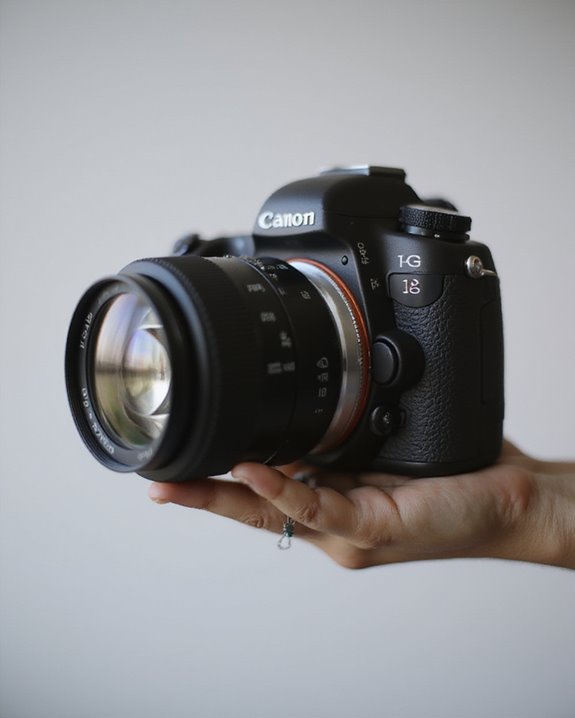To clean your Nikon camera lens, we recommend starting with a rocket blower to remove loose dust particles, followed by a microfiber cloth dampened with lens cleaning solution for stubborn smudges. Apply gentle circular motions from the center outward, avoiding direct finger contact. For persistent fingerprints, use specialized alcohol-based solutions on a fresh microfiber cloth. Protect your investment by employing lens caps, filters, and dust-proof covers when not in use. Proper maintenance techniques extend beyond these basics for best performance.
Key Takeaways
- Use a rocket blower first to remove loose dust particles before attempting any contact cleaning methods.
- Apply lens cleaning solution to a microfiber cloth (not directly on the lens) and wipe in gentle circular motions from center outward.
- Clean the lens immediately after outdoor shoots or when visible dirt accumulates to prevent damage to the coating.
- For stubborn fingerprints, use alcohol-based solutions on a microfiber cloth with gentle circular motions.
- Consider protective filters to shield your Nikon lens against scratches and UV rays while making regular cleaning easier.
Essential Tools For Cleaning Your Nikon Camera Lens
The proper maintenance of your Nikon camera lens requires a specific arsenal of cleaning implements, each serving a distinct purpose in the preservation of optical clarity. In our thorough Tool Selection process, we’ve identified five essential items: lint-free lens tissues, specialized lens cleaning solution, premium microfiber cloths, an air blower, and supplementary maintenance accessories. When conducting Brand Comparisons, we’ve found that manufacturer-approved solutions often yield superior results, though third-party alternatives can be equally effective at lower price points. We recommend investing in a dedicated cleaning kit with Nikon-compatible components, ensuring the blower maintains proper airflow control, and selecting microfiber cloths with at least 80% polyester composition for best results. These tools, when used correctly, will extend your lens’s operational lifespan considerably. Proper cleaning techniques also help prevent sensor damage and keep your images sharp and clear over time.
Prevention: Keeping Your Nikon Lens Dust-Free
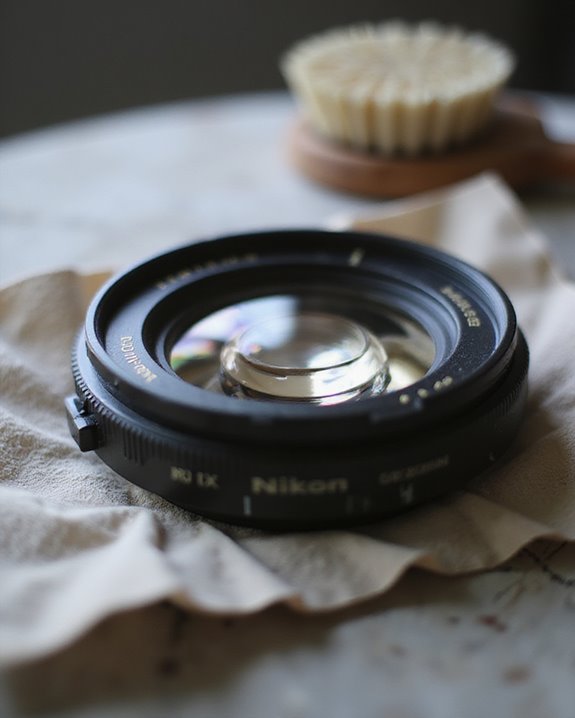
While selecting the right cleaning tools forms the foundation of proper lens maintenance, preventing dust accumulation in the first place can greatly reduce your cleaning frequency and protect your valuable Nikon optics. We recommend employing dust-proof covers and equipment bags when transporting your gear, as these create effective barriers against environmental contaminants. When shooting in dusty environments, implement proper wind protection strategies by positioning yourself with the breeze at your back and utilizing lens hoods to shield the front element. Static control is vital, as electrostatic charges attract dust particles; use anti-static cloths and materials when handling your equipment. Additionally, minimize lens changes in exposed conditions, always attach body caps immediately when detaching lenses, and store your Nikon gear with silica gel packets to regulate humidity levels, which can contribute to dust adhesion. Using high-quality microfiber cloths can also help prevent scratches and keep your lenses clean and clear.
Basic External Cleaning Technique For Nikon Lenses
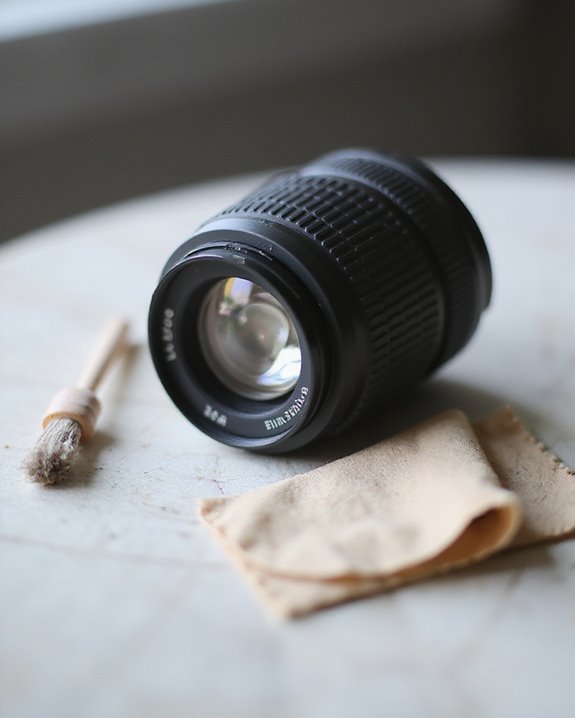
Proper external cleaning techniques form the cornerstone of effective lens maintenance, guaranteeing your Nikon glass delivers best image quality and maintains its value over time. We recommend starting with a rocket blower to remove loose dust particles before any contact cleaning begins. When stubborn debris remains, slightly dampen a high-quality microfiber cloth with distilled water or dedicated lens solution, avoiding harsh chemicals that could damage the lens coating. Using non-toxic lens cleaners helps preserve the delicate coatings and ensures a streak-free finish. Apply the damp cloth using Circular Wiping motions, working from the center outward with Gentle Pressure to avoid scratching the delicate glass elements. This technique guarantees even cleaning without leaving streaks or smudges. After cleaning, use a dry portion of your microfiber cloth to remove any remaining moisture, and inspect the lens under bright light for any missed spots.
Removing Stubborn Smudges And Fingerprints
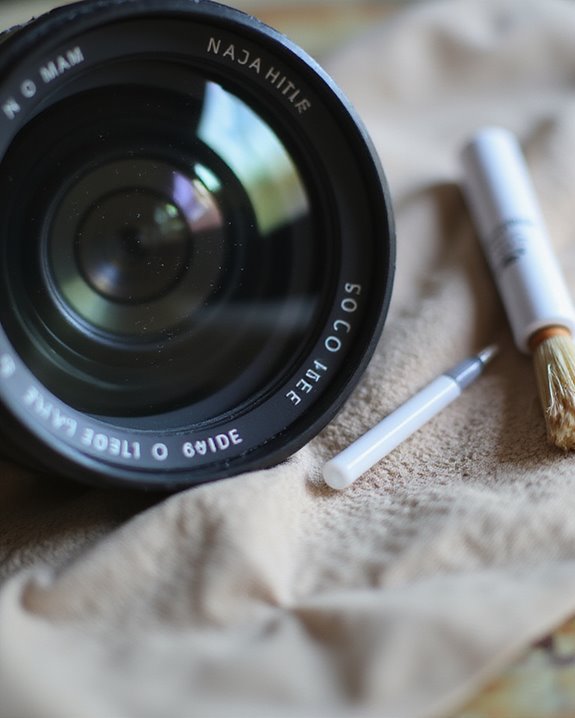
Tackling stubborn smudges and fingerprints on your Nikon lens requires methodical technique and appropriate materials to avoid damaging delicate optical coatings. Understanding Smudge Causes is essential; oils from skin, environmental contaminants, and improper cleaning can all contribute to persistent marks. We recommend using an air blower first to remove loose particles before addressing the smudge itself.
For Fingerprint Patterns, which typically present as swirled or circular marks with distinct oil residue, we utilize alcohol-based solutions applied to microfiber cloths—never directly to the lens. Working in a dust-free environment, apply gentle circular motions to lift residue without scratching. For particularly stubborn areas, a lens cleaning pin can provide precision, but exercise extreme caution. Preventative measures, including wearing gloves when handling equipment and consistently using lens caps, greatly reduce fingerprint occurrence.
Tackling Internal Lens Dust On Nikon Equipment
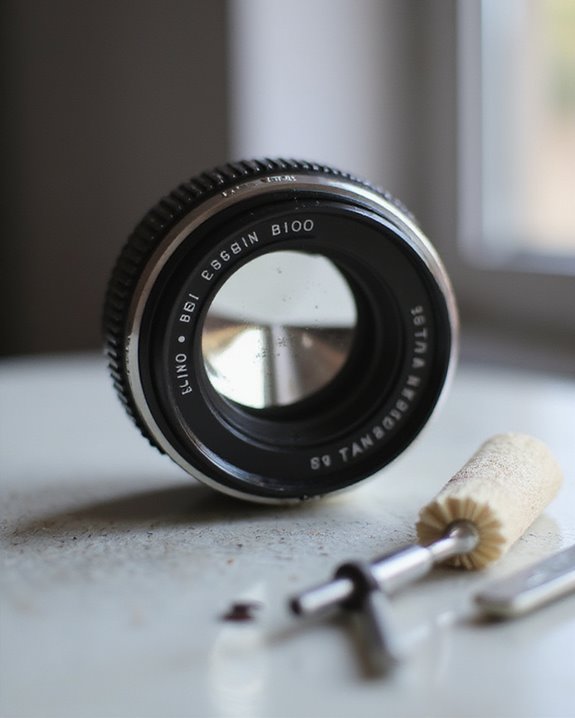
Why do even meticulously maintained Nikon lenses eventually develop internal dust? The reality is that microscopic particles can infiltrate lens assemblies during normal zoom and focus operations, gradually accumulating despite careful handling. When examining internal dust, we must first evaluate whether the contamination causes noticeable image distortion, as minor specks rarely affect image quality.
Before attempting self-cleaning, consider warranty concerns—Nikon’s standard coverage doesn’t include dust removal, and disassembly will void remaining protection. For moderate dust accumulation, try non-invasive methods first: use a rocket blower with the lens positioned to allow gravity to assist particle removal. For persistent issues, work in a dust-free environment and employ gentle tapping techniques to dislodge particles. Remember, improper cleaning attempts may introduce more contamination or damage optical coatings, potentially creating issues worse than the original dust.
When To Seek Professional Cleaning Services
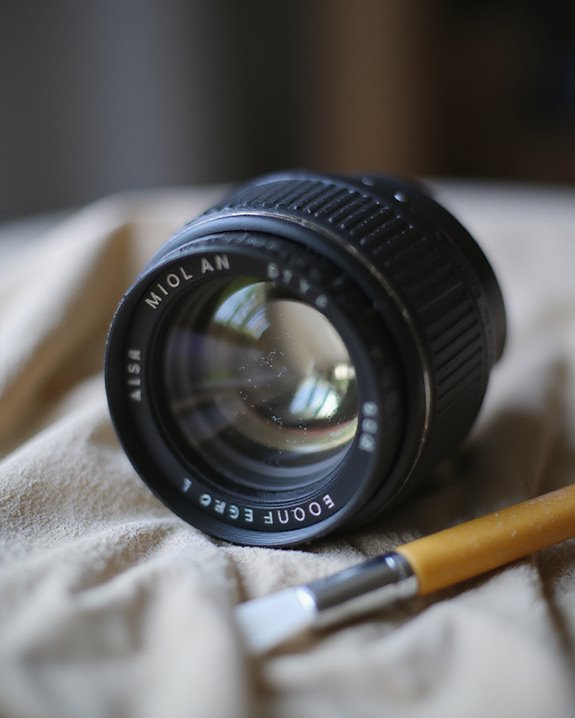
When should you entrust your valuable Nikon equipment to professional cleaning services rather than attempting DIY solutions? We recommend professional intervention when you consistently notice dark spots or marks on your images that don’t disappear with basic cleaning methods. A thorough Cost Analysis reveals that while professional services range from $75-$80, this investment prevents potential damage from DIY attempts that could result in costly repairs. Professional cleaning includes thorough care: sensor cleaning, mirror box maintenance, and functionality checks for autofocus and exposure systems. Consider Expert Consultation when your camera has been exposed to harsh environments, shows visible debris accumulation, or hasn’t undergone maintenance for over a year. Nikon certified technicians provide specialized care with quick 24-48 hour turnaround times, ensuring your equipment maintains peak performance with minimal downtime.
Maintaining Your DSLR Mirror And Sensor
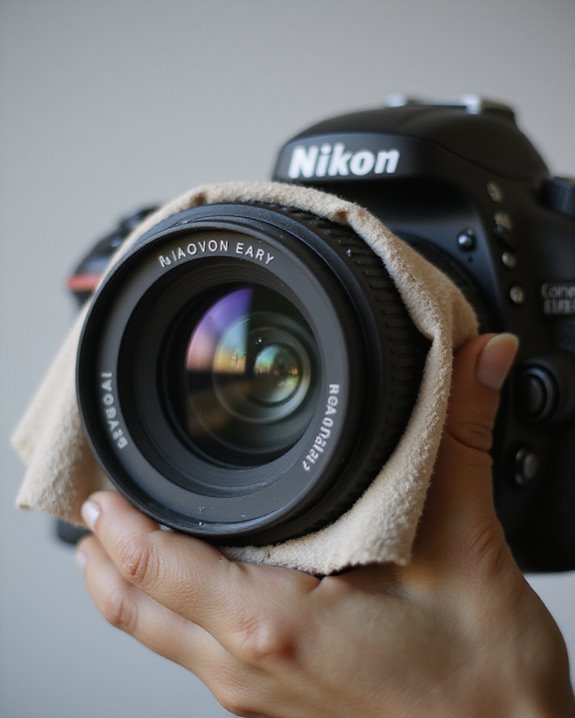
While professional services offer thorough care for your Nikon equipment, many photographers prefer handling routine maintenance themselves. For effective Sensor Maintenance, always activate your camera’s sensor-cleaning mode, which locks the mirror up for direct access. Begin by using a blower brush to remove loose particles before applying a specialized cleaning solution with single-stroke motions using proper sensor swabs matched to your sensor size.
When addressing the mirror, which doesn’t require frequent Mirror Upgrades but does need occasional cleaning, engage the mirror lock-up function, then apply minimal 99% isopropyl alcohol with foam-tipped swabs. Always wipe in one direction to prevent smearing, and immediately dry with a clean swab. We recommend testing your results by taking f/22 test shots against a white surface, which will reveal any remaining spots or debris.
Safe Storage Practices To Minimize Cleaning Needs
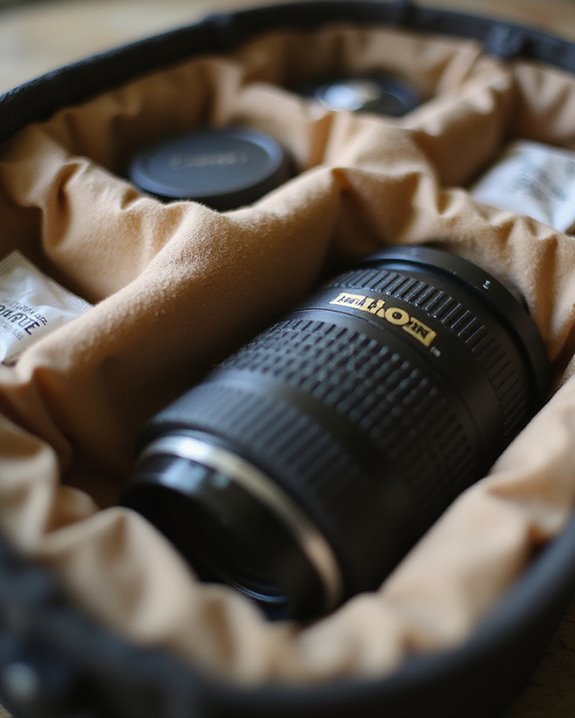
Proper storage of your Nikon camera equipment represents one of the most essential yet often overlooked aspects of lens maintenance. We recommend storing lenses with front elements facing downward in padded, purpose-built camera bags with separate compartments to prevent dust accumulation and physical damage. Temperature Management is essential—maintain stable conditions between 15-25°C (59-77°F) and avoid environments with fluctuating temperatures or high humidity that promote fungal growth on optical elements.
For Battery Storage, always remove batteries from your Nikon during extended periods of non-use, storing them separately in cool, dry locations to prevent leakage and corrosion inside compartments. Implement airtight containers with silica gel desiccants to control humidity levels, and remember to operate your camera at least monthly, releasing the shutter several times to prevent mechanical stiffness and moisture buildup.
Frequently Asked Questions
Can Household Glass Cleaners Be Used on Nikon Lenses?
Like a bull in a china shop, household glass cleaners are serious hazards for Nikon lenses. We don’t recommend them due to cleaner compatibility issues. They’ll damage lens coatings and may void your warranty.
How Often Should I Clean My Nikon Camera Lens?
We recommend cleaning your Nikon lens based on your usage frequency. For hobbyists, seasonal maintenance is sufficient, while professionals should check after each shoot. Clean immediately if you notice smudges or performance issues.
Will Condensation Damage My Lens if Cleaned Immediately?
We clean, we protect, we preserve. Condensation won’t damage your lens if cleaned immediately, but it’s still important. For Moisture Prevention, we recommend using silica gel packets and avoiding rapid temperature changes when possible.
Can Lens Cleaning Wipes Replace Proper Cleaning Solutions?
We don’t recommend using wipes as complete solution substitutes. While they offer convenience, wipe efficacy is limited for thorough cleaning. They’re good for quick touch-ups, but proper solutions provide better results for deep cleaning.
Does UV Filter Cleaning Eliminate the Need for Lens Cleaning?
No, a common Cleaning Myth! While we clean the UV Filter regularly, dirt still sneaks behind it. We’d be mistaken to think Filter Necessity means we’re free from lens cleaning entirely—both need attention.


